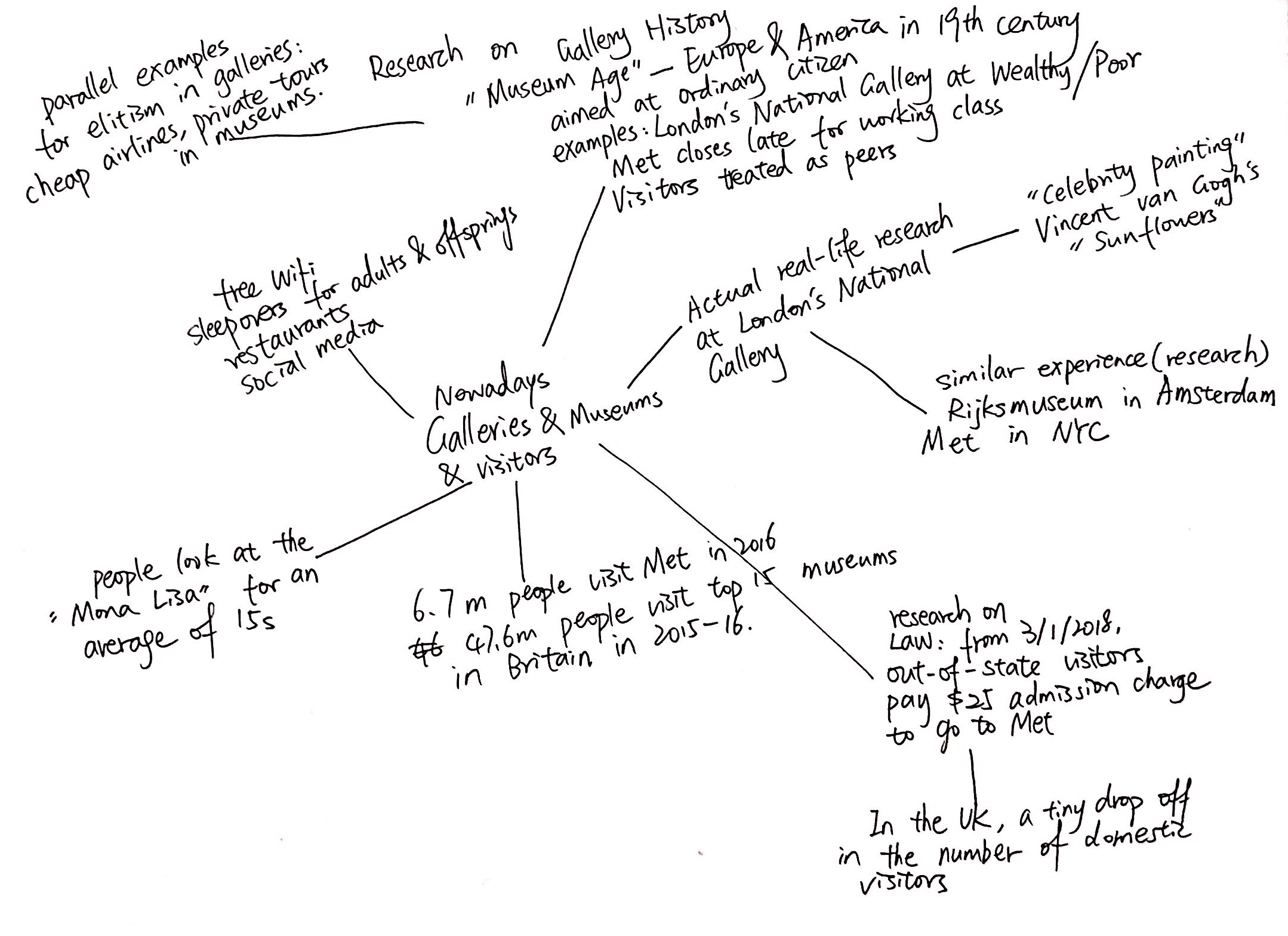Gallery crowds are killing the joys of visual culture
https://www.ft.com/content/dbe8acfc-e0e5-11e7-a0d4-0944c5f49e46
- words that are central to the article
Desire, encounter, celebrity paintings, assembled, queue, glimpse, pools of children, sprawling teenagers, hordes of people, indifferent, whopping, average of 15 seconds, bulletproof glass case, cultivated, aesthetic or intellectual appreciation, social media gimmicks, prove value for money, measure achievement in metrics, democratising, elitism, condescended.
- the main themes the article touches on
Nowadays’ museums and galleries values money and reputation more than cultivate or educate ordinary citizens.
People are chasing after “celebrity paintings” rather than really appreciate artworks nowadays.
- Research questions the author may asked before beginning work on this article
Which museums or galleries have the most visiting numbers per day/week/month/year worldwide? The growth/decrease visiting number of important museums/galleries last decades?
What the average price of a museum’s ticket?
What considerations staff would make when choosing an artwork to put into galleries?
What the most/least popular artwork in a museum? What kind of artwork visitors would like to see?
What’s the average time a visitor/a group of visitors would stay in a museum? How long would a visitor spend in front of one artwork? What visitors would usually do in a museum/a gallery?
- the thesis of the article
Museums and galleries gradually become the tool of elitism, which contradict the original idea of building museums and galleries. Also people nowadays lack aesthetic or intellectual appreciation to appreciate art, and they would only go to “famous” museums and galleries to see “star paintings”.
- Research the author/publication of the piece
Tiffany Jenkins (the author of the article) is an author, academic, broadcaster and consultant on cultural policy. Her writing credits include the Observer, the Art Newspaper, the Scotsman (for which she was a weekly columnist on social and cultural issues) and the Spectator. She competed her PhD in Sociology at the University of Kent. (Cite from https://tiffanyjenkinsinfo.com/about/) She also is the author of Contesting Human Remains in Museum Collections (2011), which looks at the influences at play on the controversy over human remains in museum collections. (Cite from https://en.wikipedia.org/wiki/Tiffany_Jenkins)
A speech Tiffany Jenkins gave at TedTalk:
An interview of Tiffany Jenkins:
Publication of the article: Financial Times
The Financial Times (FT) is a Japanese-owned, English-language international daily newspaper with a special emphasis on business and economic news. The Financial Times has an average daily readership of 2.2 million people worldwide (PwC audited figures, November 2011). FT.com has 4.5 million registered users and over 285,000 digital subscribers, as well as 600,000 paying users. (Cite from https://en.wikipedia.org/wiki/Financial_Times )
It’s homepage: https://www.ft.com
- the agenda of the article
I think the agenda of this article is awaking people from meaningless chasing after “famous museums” and “celebrity paintings” and expressing the importance of citizen’s ability of appreciating art. Also the article states how institutions and government should educate and cultivate ordinary citizens using museums and galleries rather than focus on profits and reputations.
- information that needed to be researched
“Whether it is the Rijksmuseum in Amsterdam, where you have to queue to glimpse a Rembrandt, or the Metropolitan Museum of Art in New York, where you wade through pools of children and step over sprawling teenagers to catch sight of the Assyrian sculptures, great art is hidden by hordes of people who seem indifferent to it.”
“During the fiscal year of 2016, 6.7m people visited the Metropolitan Museum of Art, the highest number since it began tracking admission figures over 40 years ago. Figures published by the UK’s Department for Digital, Culture, Media and Sport show a whopping 47.6m visits were made to the top 15 museums in Britain in 2015-16.”
“The Louvre in Paris found that people look at the ‘Mona Lisa’ through its bulletproof glass case for an average of 15 seconds.”
“”Over the past few decades, as cultural institutions had to prove value for money, they lost confidence in their collections and, paradoxically, the audience. As a result, they tend to measure achievement in metrics.”
- mind map of all the different sources the author used
- Define 5-10 unfamiliar words
Elitism: the advocacy or existence of an elite as a dominating element in a system or society
Metrics: a method of measuring something
Gimmick: a trick or device intended to attract attention, publicity, or business
Caricature: a picture, description, or imitation of a person in which certain striking characteristics are exaggerated in order to create a comic or grotesque effect
Woe: great sorrow or distress
Decorous: in keeping with good taste and propriety; polite and restrained
